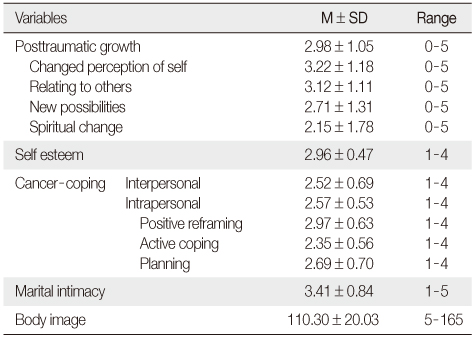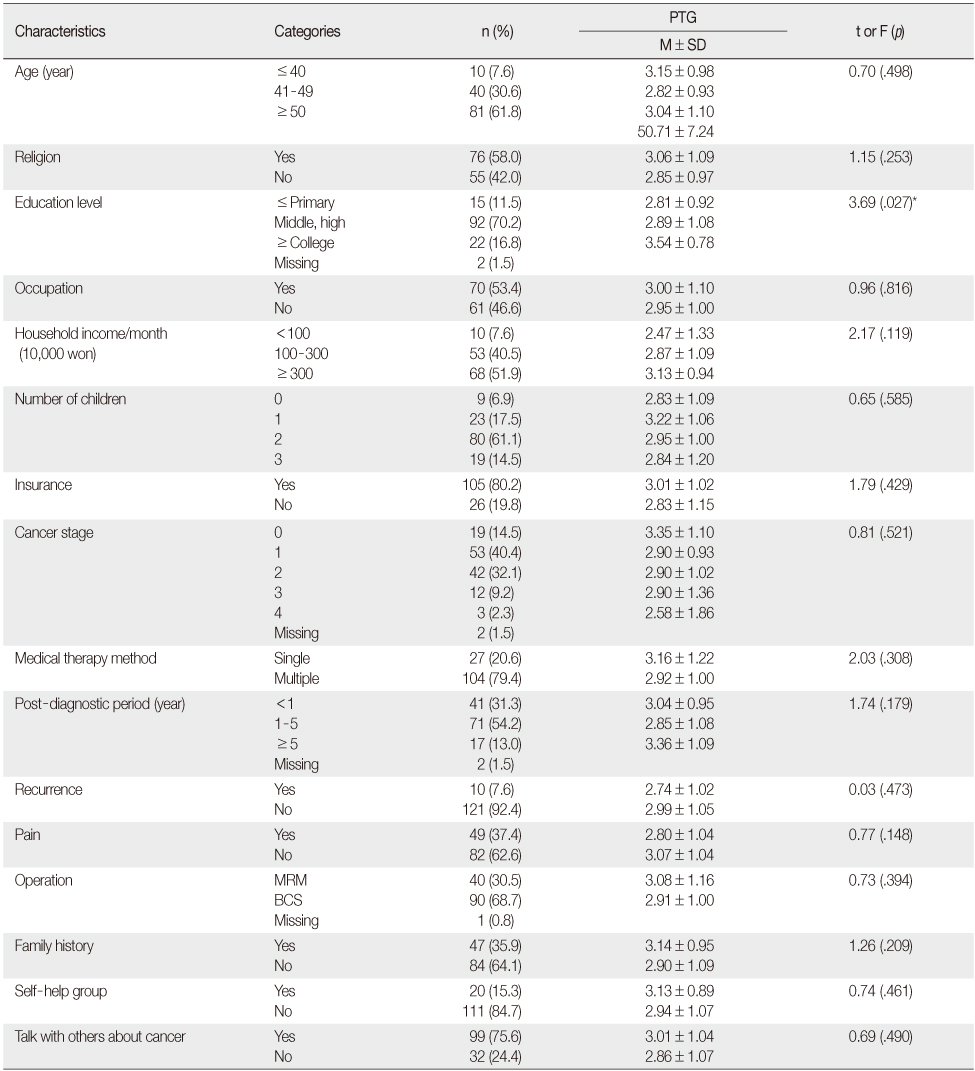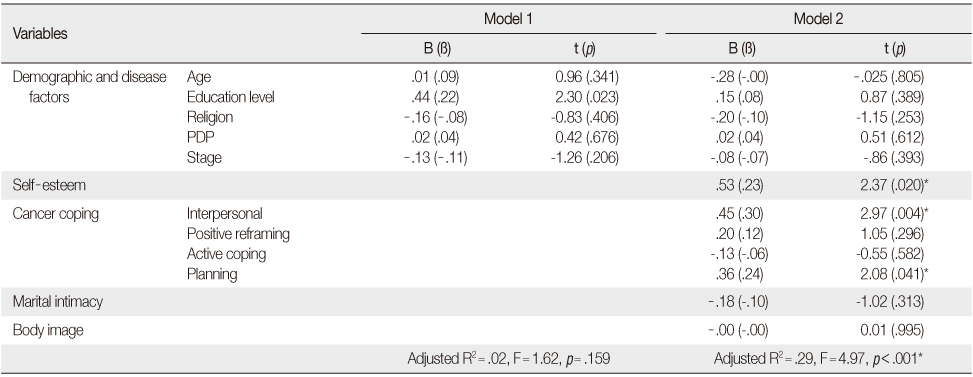Articles
- Page Path
- HOME > J Korean Acad Nurs > Volume 42(6); 2012 > Article
-
Original Article
- Posttraumatic Growth of Patients with Breast Cancer
- Sook Lee, Yeon Jung Kim
-
Journal of Korean Academy of Nursing 2012;42(6):907-915.
DOI: https://doi.org/10.4040/jkan.2012.42.6.907
Published online: December 31, 2012
1Division of Nursing, Dankook University, Cheonan, Korea.
2Counseling and Mediation Center, Dankook University, Cheonan, Korea.
- Address reprint requests to: Kim, Yeon Jung. Counseling and Mediation Center, Dankook University, 119 Dandae-ro, Dongnam-gu, Cheonan 330-714, Korea. Tel: +82-41-550-1295, Fax: +82-41-559-7832, yjkim00@dankook.ac.kr
© 2012 Korean Society of Nursing Science
- 758 Views
- 3 Download
- 20 Crossref
Abstract
-
Purpose
- A diagnosis of breast cancer is one of the most traumatic events that threatens a woman's life, but while women adapt to and overcome these threats, they not only experience negative aspects, but also growth. The purpose of this study was to identify the many factors that affect growth, and to provide fundamental information for nursing interventions, which can help the women in their growth.
-
Methods
- The participants in this study were 131 married women patients with breast cancer, who were on medical treatment in one of two university hospitals, in Seoul and Chungnam. Data were collected for posttraumatic growth, self-esteem, cancer coping questionnaire, marital intimacy, and body image. The data were analyzed using the SPSS 19.0 program (IBM).
-
Results
- Interpersonal cancer coping, intrapersonal cancer coping (planning) and self-esteem accounted for 29.0% of posttraumatic growth.
-
Conclusion
- These findings indicate that in order to help the women's growth after the trauma of breast cancer, it is necessary to enhance their self-esteem, and to develop psycho-social nursing supportive programs.
- 1. Baxter NN, Goodwin PJ, McLeod RS, Dion R, Devins G, Bombardier C. Reliability and validity of the body image after breast cancer questionnaire. Breast J. 2006;12(3):221–232. http://dx.doi.org/10.1111/j.1075-122X.2006.00246.x.ArticlePubMed
- 2. Cho OH, Yoo YS. Psychosocial adjustment, marital intimacy and family support of post-mastectomy patients. J Korean Oncol Nurs. 2009;9(2):129–135.
- 3. Choi JH. Posttraumatic growth in cancer patients. 2011;Busan, Catholic University of Pusan. Unpublished master's thesis.
- 4. Chung SW, Hwang EK, Hwang SW. Marital intimacy and quality of life in women with breast cancer. J Korean Oncol Nurs. 2009;9(2):122–128.
- 5. Falk Dahl CA, Reinertsen KV, Nesvold IL, Fosså SD, Dahl AA. A study of body image in long-term breast cancer survivors. Cancer. 2010;116(15):3549–3557. http://dx.doi.org/10.1002/cncr.25251.ArticlePubMed
- 6. Han IY, Lee IJ. Posttraumatic growth in patients with cancer. Korean J Soc Welf Stud. 2011;42(2):419–441.Article
- 7. Heijer M, Seynaeve C, Vanheusden K, Duivenvoorden HJ, Vos JV, Bartels CCM, et al. The contribution of self-esteem and self-concept in psychological distress in women at risk of hereditary breast cancer. Psychooncology. 2011;20(11):1170–1175. http://dx.doi.org/10.1002/pon.1824.ArticlePubMed
- 8. Jon BJ. Self-esteem: A test of its measurability. Yonsei Nonchong. 1974;11(1):107–130.
- 9. Kim HJ, Kwon JH, Kim JN, Lee R, Lee KS. Posttraumatic growth and related factors in breast cancer survivors. Korean J Health Psychol. 2008;13(3):781–799.Article
- 10. Kim JN, Kwon JH, Kim SY, Yoo BH, Hur JW, Sung HJ, et al. Validation of Korean-cancer coping questionnaire (K-CCQ). Korean J Health Psychol. 2004;9(2):395–414.
- 11. Kim SH, Lee ES. The stress and adaptation of the spouses of patients with gynecological cancer. J Korean Oncol Nurs. 2006;6(2):162–171.
- 12. Koo BJ. The influence of resilience, hope, marital intimacy, and family support on quality of life for middle-aged women. J Korean Acad Psychiatr Ment Health Nurs. 2008;17(4):421–430.ArticlePDF
- 13. Lee KH. Marriage types classified by wives' perception of marital conflict and intimacy. 1998;Seoul, Seoul University. Unpublished doctoral dissertation.
- 14. Lee YS. Psychosocial experience in post-mastectomy women. Korean J Soc Welf. 2007;59(3):99–124.Article
- 15. Lepore SJ, Glaser DB, Roberts KJ. On the positive relationbetween received social support and negative affect: A test of the triage and self-esteem threat models in women with breast cancer. Psychooncology. 2008;17(12):1210–1215. http://dx.doi.org/10.1002/pon.1347.ArticlePubMed
- 16. Linley PA, Joseph S. Positive change following trauma and adversity: A review. J Trauma Stress. 2004;17(1):11–21. http://dx.doi.org/10.1023/B:JOTS.0000014671.27856.7e.ArticlePubMed
- 17. Moorey S, Frampton M, Greer S. The cancer coping questionnaire: A self-rating scale for measuring the impact of adjuvant psychological therapy on coping behaviour. Psychooncology. 2003;12(4):331–344. http://dx.doi.org/10.1002/pon.646.ArticlePubMed
- 18. National Comprehensive Cancer Network. NCCN practice guidelines in oncology. 2007;Retrieved 2007. from http://www.nccn.org/index.asp.
- 19. National Cancer Information Center. Cancer statistics. 2012;Retrieved January 2, 2012. from http://www.cancer.go.kr/ncic/cics_f/01/012/index.html.
- 20. Posluszny DM, Baum A, Edwards RP, Dew MA. Posttraumatic growth in women one year after diagnosis for gynecologic cancer or benign conditions. J Psychosoc Oncol. 2011;29(5):561–572. http://dx.doi.org/10.1080/07347332.2011.599360.ArticlePubMed
- 21. Rosenberg M. Society and the adolescent self-image. 1965;Princeton, NJ, Princeton University press.
- 22. Smith BW, Dalen J, Bernard JF, Baumgartner KB. Posttraumatic growth in non-Hispanic White and Hispanic women with cervical cancer. J Psychosoc Oncol. 2008;26(4):91–109. http://dx.doi.org/10.1080/07347330802359768.ArticlePubMed
- 23. Song SH, Lee HS, Park JH, Kim KH. Reliability and validity of the Korean version of the posttraumatic growth inventory. Korean J Health Psychol. 2009;14(1):193–214.
- 24. Statistical Korea. I wish I could have more respect for myself. 2004;Retrieved 2004. from http://kosis.kr/gen_etl/start.jsp?orgId=110&tblId=TX_12019_A332&conn_path=I2&path=NSI.
- 25. Tedeshi RG, Calhoun LG. The posttraumatic growth inventory: Measuring the positive legacy of trauma. J Trauma Stress. 1996;9(3):455–471. http://dx.doi.org/10.1002/jts.2490090305.ArticlePubMed
- 26. Tedeshi RG, Calhoun LG. Posttraumatic growth: Conceptual foundations and empirical evidence. Psychol Inq. 2004;15(1):1–18. http://dx.doi.org/10.1207/s15327965pli1501_01.
- 27. Yang AJ. Mindfulness, positive cancer coping styles and posttraumatic growth in breast cancer survivors-the mediating effect of positive coping style. 2009;Seoul, Ewha Womans University. Unpublished master's thesis.
- 28. Yoon MO, Park JS. Live spiritual experiences of patients with terminal cancer. J Korean Acad Community Health Nurs. 2003;14(3):445–456.
- 29. Yu MS, Lee SY. The validation of the Korean version of body image after breast cancer questionnaire. Korean J Play Ther. 2010;13(1):65–81.
- 30. Zwahlen D, Hagenbuch N, Carley MI, Jenewein J, Buchi S. Posttraumatic growth in cancer patients and partners-effects of role, gender and the dyad on couples’ posttraumatic growth experience. Psychooncology. 2010;19:12–20. http://dx.doi.org/10.1002/pon.1486.ArticlePubMedPDF
REFERENCES

Figure & Data
REFERENCES
Citations

- Structural Equation Model for Psychosocial Adjustment of Breast Cancer Survivors Based on Family Resilience Model
Jiyoung Seo, Myungsun Yi
Korean Journal of Adult Nursing.2022; 34(2): 178. CrossRef - Development and effects of a post-traumatic growth program for patients with breast cancer
Sung Hee Choi, Young Whee Lee, Hwa Soon Kim, Soo Hyun Kim, Eun-Hyun Lee, Eun Young Park, Young Up Cho
European Journal of Oncology Nursing.2022; 57: 102100. CrossRef - Posttraumatic Growth and Health Promotion Behavior in Patients with Cancer: The Mediating Effect of Spiritual Well-Being
Shunji Piao, Pok Ja Oh
Asian Oncology Nursing.2021; 21(1): 33. CrossRef - The effectiveness of acceptance and commitment therapy on the rate of acceptance and post-traumatic growth in colorectal cancer patients comorbid with stress
Ahmad kazemipour, Fazlolah mirderikvand, Kourosh amraei
Health Monitor Journal of the Iranian Institute for Health Sciences Research.2020; 19(5): 569. CrossRef - Post-traumatic Growth among Stroke Patients: Impact of Hope, Meaning in Life, and Social Support
Young-Ju Jeong, Hee Sun Kim
Korean Journal of Adult Nursing.2019; 31(6): 605. CrossRef - A Structural Equation Model of Factors Influencing Posttraumatic Growth of Earthquake Victims
Minyeong Kwak
Journal of Korean Academy of Community Health Nursing.2019; 30(3): 345. CrossRef - Factors Influencing Posttraumatic Growth of Gynecologic Oncology Patients Undergoing Chemotherapy
Sun Jeong Yun, Hye Young Kim
Korean Journal of Women Health Nursing.2019; 25(4): 409. CrossRef - The Influence of Spiritual Well-Being, Self-Esteem, and Perceived Social Support on Post-Traumatic Growth among Breast Cancer Survivors
Eun Young Seo, Suhye Kwon
Asian Oncology Nursing.2018; 18(4): 232. CrossRef - The Relationship between Post-Traumatic Growth, Trauma Experience and Cognitive Emotion Regulation in Nurses
Sook Lee, Mun Gyeong Gwon, YeonJung Kim
Korean Journal of Stress Research.2018; 26(1): 31. CrossRef - Posttraumatic growth in breast cancer survivors and their husbands based on the actor‐partner interdependence model
MyoSuk Lee, Kyunghee Kim, Changwon Lim, Ji‐Su Kim
Psycho-Oncology.2017; 26(10): 1586. CrossRef - Comparison of Perception of Successful Aging between Late Middle-aged Breast Cancer Survivors and Healthy Women
Eun Ja Kim, Nahyun Kim
Journal of Korean Gerontological Nursing.2017; 19(1): 48. CrossRef - Self-Efficacy, Self-Care Behavior, Posttraumatic Growth, and Quality of Life in Patients with Cancer according to Disease Characteristics
Jinho Choi, Sunyoung Lee, Byungduck An
The Korean Journal of Hospice and Palliative Care.2016; 19(2): 170. CrossRef - The Effects of Self-esteem and Problem Focused Coping on Post-traumatic Growth among Police Officers
Seung Woo Han, Eunsuk Choi
Korean Journal of Occupational Health Nursing.2016; 25(3): 141. CrossRef - Factors Influencing Posttraumatic Growth in Survivors of Breast Cancer
Jin-Hee Park, Yong-Sik Jung, Youngmi Jung
Journal of Korean Academy of Nursing.2016; 46(3): 454. CrossRef - Factors Related to Posttraumatic Growth in Patients with Colorectal Cancer
Hyeon Ju Lee, Seong Sook Jun
Korean Journal of Adult Nursing.2016; 28(3): 247. CrossRef - Influencing Factors for Post-traumatic Growth in Patients with Breast Cancer
Sung-Hee Choi, Young-Whee Lee
The Journal of the Korea Contents Association.2016; 16(11): 499. CrossRef - The Effects of Posttraumatic Growth and Meaning in Life on Health Promotion Behavior in Cancer Patients
Sun-Hee Jang, Hae-Rang Lee, Hyung-Nam Yeu, Soon-Ock Choi
Asian Oncology Nursing.2014; 14(2): 100. CrossRef - Posttraumatic Growth, Dyadic Adjustment, and Quality of Life in Breast Cancer Survivors and Their Husbands
Seunghee Song, Eunjung Ryu
Journal of Korean Academy of Nursing.2014; 44(5): 515. CrossRef - Changes of Self-efficacy, Depression, and Posttraumatic Growth in Survivors with Breast Cancer Participating Breast Cancer Prevention Volunteering
Myungsun Yi, Jieun Cha, Youngmi Ryu
The Journal of the Korea Contents Association.2014; 14(4): 256. CrossRef - Effects of a Cancer-Overcome BeHaS Exercise Program on Post-trauma Risk and Anxiety in Breast Cancer Patients
Sun Ae Kim, Jong Im Kim, Sun Young Park
Journal of muscle and joint health.2014; 21(1): 27. CrossRef
Posttraumatic Growth according to Demographic and Disease Characteristics (N=131)
PTG=Posttraumatic growth; MRM=Modified radical mastectomy; BCS=Breast conserving surgery.
Scores for Posttraumatic Growth, Self-esteem, Cancer-coping, Marital Intimacy and Body Image (N=131)
Correlation of Posttraumatic Growth, Self-esteem, Cancer-coping, Marital Intimacy and Body Image (N=131)
Factors related to Posttraumatic Growth (N=131)
PDP=Postdiagnostic period.
PTG=Posttraumatic growth; MRM=Modified radical mastectomy; BCS=Breast conserving surgery.
PDP=Postdiagnostic period.
 KSNS
KSNS
 E-SUBMISSION
E-SUBMISSION



 Cite
Cite

